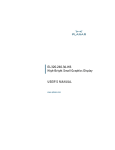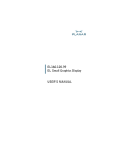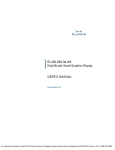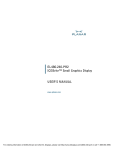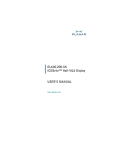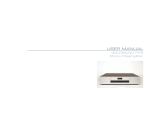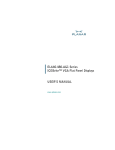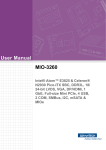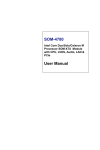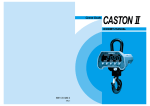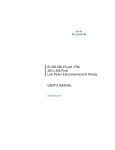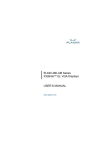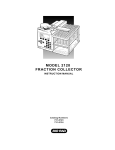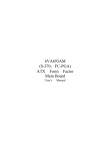Download EL320.240.36-HB High-Bright Small Graphics
Transcript
EL320.240.36-HB High-Bright Small Graphics Display USER’S MANUAL Revision Control Date Description September 2001 Document number OM220-01 June 2004 Document number 020-0346-00A Contents EL320.240.36-HB Quarter-VGA Display..............................................................................................................2 Features and Benefits ..........................................................................................................................................2 Installation and Handling........................................................................................................................................3 Mounting EL Displays ..........................................................................................................................................3 Cable Length...........................................................................................................................................................4 Cleaning ...................................................................................................................................................................4 Avoiding Burn-In ...................................................................................................................................................4 Specifications ..............................................................................................................................................................5 Control Basics .........................................................................................................................................................5 Power.........................................................................................................................................................................5 Connector ................................................................................................................................................................6 Dimming Connector J2.................................................................................................................................. 7 Interface Information...........................................................................................................................................7 Video Input Signals.......................................................................................................................................... 7 Internal Frame Buffer...........................................................................................................................................9 Dimming ..................................................................................................................................................................9 Self-Test Mode........................................................................................................................................................9 Optical.....................................................................................................................................................................10 Environmental......................................................................................................................................................10 Reliability................................................................................................................................................................11 Safety and EMI Performance ...........................................................................................................................11 Optional Features ................................................................................................................................................11 Mechanical Characteristics ..............................................................................................................................11 Component Envelope .......................................................................................................................................11 Description of Warranty ........................................................................................................................................13 Ordering Information .............................................................................................................................................13 Support and Service................................................................................................................................................14 Figures Figure 1. Data/Power Connector.....................................................................................................................6 Figure 2. Video Input Timing Diagram ..........................................................................................................7 Figure 3. Pixel Location versus Sequence of Data.....................................................................................8 Figure 4. Display Dimensions..........................................................................................................................12 Tables Table 1. DC Input Voltage Requirements. ....................................................................................................5 Table 2. Video Input Requirements. ...............................................................................................................5 Table 3. J1 Connector Pinouts. .........................................................................................................................6 Table 4. Video Input Descriptions. ..................................................................................................................8 Table 5. Luminance Control ..............................................................................................................................9 Table 6. Optical Characteristics. .....................................................................................................................10 Table 7. Environmental Characteristics.......................................................................................................10 Table 8. Mechanical Characteristics..............................................................................................................11 EL320.240.36-HB Quarter-VGA Display The EL320.240.36-HB thin film electroluminescent (EL) display is a highperformance alternative to quarter-VGA LCDs and is the ideal solution in demanding applications where superior visual performance and environmental ruggedness are critical. The EL320.240.36-HB utilizes Planar’s proprietary Integral Contrast Enhancement (ICE™) technology to achieve unparalleled image quality without the use of expensive filters. This small graphics display excels in a wide range of ambient lighting environments while effectively eliminating the blooming common to other high-bright displays. The display consists of an EL glass panel and control electronics assembled into a space-saving, rugged package for easy mounting. The EL320.240.36HB is easily interfaced using standard 4-bit LCD control signals. Each of the 76,800 pixels is individually addressable to clearly display high information content graphics and text. Features and Benefits 2 • Excellent visual performance: High brightness and contrast Wide viewing angle > 160° • Rapid display response < 1 ms • Frame Buffer • Space efficient mechanical package • Low EMI emissions • Extremely rugged and durable • Reliable, long operating life • 4-bit LCD-type interface EL320.240.36-HB Operations Manual (020-0346-00A) Installation and Handling Do not drop, bend, or flex the display. Do not allow objects to strike the surface of the display. CAUTION: The display uses CMOS and power MOS-FET devices. These components are electrostatic sensitive. Unpack, assemble, and examine this assembly in a static-controlled area only. When shipping, use packing materials designed for protection of electrostatic-sensitive components. Mounting EL Displays Properly mounted, EL displays can withstand high shock loads as well as severe vibration found in demanding applications. However the glass panel used in an EL display will break if subjected to bending stresses, high impact, or excessive loads. Avoid bending the display. Stresses are often introduced when a display is mounted into a product. Ideally, the mounting tabs of the display should be the only point of contact with the system. Use a spacer or boss for support; failure to do so will bend the display and cause the glass to break. The instrument enclosure or frame should not flex or distort in such a way that during use the bending loads might be transferred to the display. The EL320.240.36-HB mounting tabs were designed for a 3 mm screw. Mounting surfaces should be flat to within ±0.6 mm (±0.025"). Use all the mounting holes provided. Failure to do so will impair the shock and vibration resistance of the final installation. CAUTION: To prevent injury in the event of glass breakage, a protective overlay should be used on the viewer side of the display. WARNING: These products generate voltages capable of causing personal injury (high voltage up to 235 Vac ). Do not touch the display electronics during operation. EL320.240.36-HB Operations Manual (020-0346-00A) 3 Cable Length A maximum cable length of 0.6 m (24 in.) is recommended. Longer cables may cause data transfer problems between the data transmitted and the display input connector. Excessive cable lengths can pick up unwanted EMI. There are third party products which allow this maximum cable length to be exceeded. Contact Planar Application Engineering for more information. Cleaning As with any glass or coated surface, care should be taken to minimize scratching. Clean the display glass with mild, water-based detergents only. Apply the cleaner sparingly to a soft cloth, then wipe the display. Disposable cleaning cloths are recommended to minimize the risk of inadvertently scratching the display with particles embedded in a re-used cloth. Particular care should be taken when cleaning displays with anti-glare and anti-reflective films. Avoiding Burn-In As with other light emitting displays, use a screen saver or image inversion to avoid causing burn-in on the display. Displaying fixed patterns on the screen can cause burn-in, where luminance variations can be noticed. 4 EL320.240.36-HB Operations Manual (020-0346-00A) Specifications Performance characteristics are guaranteed when measured at 25°C with rated input voltage unless otherwise specified. Control Basics The EL panel is a matrix structure with column and row electrodes arranged in an X-Y formation. Light is emitted when an AC voltage of sufficient amplitude is applied at a row-column intersection. The display operation is based on the symmetric, line-at-a-time data addressing scheme. Power The supply voltages are shown in Table 1. All internal high voltages are generated from the display supply voltage (VH). The logic supply voltage (VL) should be present whenever video input signals or VH is applied. The minimum and maximum specifications in this manual should be met, without exception, to ensure the long-term reliability of the display. Planar does not recommend operation of the display outside these specifications. Table 1. DC Input Voltage Requirements. Parameter Symbol Logic supply voltage VL Logic supply current at +5 V Display supply voltage Supply current at +12 V Power consumption @ maximum frame rate Power consumption @ 120 Hz IL VH IH Min 4.75 V 8V Typ Max 5V 5.25 V 12 V 0.4A 5.5 W 0.10 A 18 V 0.9 A 11 W Absolute Max 6V 19V 3.5 W CAUTION: Absolute maximum ratings are those values beyond which damage to the device may occur. Table 2. Video Input Requirements. Description Min Max Units Notes Absolute Input Voltage Range Video logic high voltage Video logic low voltage Video logic input current -0.3 5.5 V VL= 5.0 V 2.2 0 – 5.0 0.8 V V mA All input thresholds are TTL Input capacitance – ±0.25 15 ±0.75 mA max Selftest pF There is no overcurrent protection on either the VH or VL inputs to protect against catastrophic faults. Planar recommends the use of a series fuse on the 12 volt supply(VH). A general guideline is to rate the fuse at 1.8 to 2 times the display maximum current rating. EL320.240.36-HB Operations Manual (020-0346-00A) 5 Connector The display uses the Samtec EHT-110-01-S-D or equivalent locking connector. The mating connector is in the Samtec TCSD family of cable strips. The proper connector, user-specified cable length and connector configuration is supplied as a single unit. Consult your Samtec representative (1-800-SAMTEC9) for the cable/connector options. Compatibility with non-Samtec equivalents should be verified before use. Pin 1 Key J1 Pin 1 Pin 2 J2 (Viewed from back of display) Pin 1 Key (Viewed from top of connector) Figure 1. Data/Power Connector Table 3. J1 Connector Pinouts. Pin Signal 1 VH Pin Signal 2 VH +12 V Power 4 SCAN Scan rate control +12 V Power 1 Description 3 Selftest Selftest Input 5 VL +5 V Power 6 GND Ground 7 VS Vertical Sync 8 GND Ground 9 HS Horizontal Sync 10 GND Ground 11 VCLK Video Clock 12 GND Ground 13 VID0 Video Data 14 GND Ground 15 VID1 Video Data 16 GND Ground 17 VID2 Video Data 18 GND Ground 19 6 Description VID3 Video Data 20 GND 1 Connect pin 3 to ground for normal display operation. EL320.240.36-HB Operations Manual (020-0346-00A) Ground Dimming Connector J2 The J2 analog dimming connector is a Berg six-pin, dual in-line header, part number 95615-106. The mating connector is the Berg 89947-706 (IDC) or a combination of the Berg 77138-001 (discrete crimp-to-wire receptacle) and the Berg 90311-006 (housing). Refer to “Dimming” on page 9 for more information. The pin assignments are: Pin 1 Pin Symbol Description 1 2 3 4 5 6 LUMA GND RESERVED LUMC GND LUMD Luminance A Ground Reserved Luminance C Ground Luminance D Interface Information Planar EL Small Graphics Displays (SGD) incorporate an interface that is similar to many LCD interfaces. This interface is supported by a variety of off-the-shelf chip sets which take care of all display control functionality, freeing the system processor for other tasks. Designers should select the chip set that best suits their particular architecture and price point. Video Input Signals The end of the top line of a frame is marked by VS, vertical sync signal as shown in Figure 2. The end of each row of data is marked by HS. Depending on the input frame rate, a continuous low state of the VS input signal will shut the display scan after one frame period. Horizontal Timing HS 6 3 VCLK 4 5 7 8 VID 0-3 Pixels: w x y z Pixels: a b c d Vertical Timing VS 10 9 1 11 2 HS First Line VID Data Second Line VID Data Figure 2. Video Input Timing Diagram. Timing is compatible with LCD graphics controllers. EL320.240.36-HB Operations Manual (020-0346-00A) 7 Table 4. Video Input Descriptions. Num 1 2 3 4 5 6 7 8 9 10 11 12 Description Symbol Min. HS high time HS low time HS to VCLK rising edge VID setup to VCLK VID hold from VCLK Video clock period VCLK rise, fall time VCLK low width VCLK high width VS high setup to HS low VS hold after HS VS low setup to HS high HS period VS period Frame Rate tHSh tHSl tHSsu tVIDsu tVIDhd tVCLK tVCLKrf tVCLKl tVCLKh tVShsu tVShd tVSlsu tHS tVS fVS 100 80 95 50 50 140 Typ. 10 30 30 140 140 140 34 240 1 Max. Units nsec tVCLK nsec nsec nsec nsec nsec nsec nsec nsec nsec nsec µsec tHS Hz 15 120 Input signals VID0 through VID3 contain the video data for the screen. Pixel information is supplied from left to right and from top to bottom four pixels at a time. Video data for one row is latched on the fall of HS. abcd efgh ijkl mn op w xyz Row 1 EL Panel (Front) VID3 a e i m w VID2 b f j n x VID1 c g k o y VID0 d h l p z Figure 3. Pixel Location versus Sequence of Data. 8 EL320.240.36-HB Operations Manual (020-0346-00A) Internal Frame Buffer This display includes an internal frame buffer. The display frame rate and the display brightness are independent of user-supplied input data timing. The display frame rate can be controlled through the digital dimming feature as described below. CAUTION: The display includes an internal frame buffer. In order to blank the display image in the event of system malfunction, pull down the VS signal. Dimming There are two standard methods for dimming the EL320.240.36-HB display. Analog dimming using the J2 dimming connector described on page 7 of this manual allows for manual dimming from 100% to approximately 5% of the full brightness. To perform analog dimming, connect a 50 k ohm variable resistor between LUMA and GND. Alternatively, an external voltage or current mode D/A converter may be used to facilitate dimming by sinking a maximum of 250 µA (for maximum dimming) from LUMA to GND on the input connector. Open circuit voltage is 4 V nominal. The internal scan frequency can be controlled via the LUMC and LUMD inputs. When LUMC and LUMD are left open, the scan rate is determined by the SCAN signal (pin 4) on the data input connector. With the combination of LUMC and LUMD, the following and luminance levels are obtained: Table 5. Luminance Control Approx. Relative luminance 100% 75% 50% 30% 100% 50% LUMD (internal pull up) High High Low Low Open Open LUMC (internal pull up) High Low High Low Open Open SCAN (J1 pin 4) Open Open Open Open High Low Self-Test Mode The display incorporates a self-test mode composed of two patterns displayed at maximum frame rate for approximately 30 seconds each, and then repeated. The patterns are as follows: 50/50 Checkerboard and Full On. The self-test mode is entered by leaving pin 3 on J1 unconnected or pulled high. This pin has an internal pull-up. Connect pin 3 on J1 to Ground for normal display operation. EL320.240.36-HB Operations Manual (020-0346-00A) 9 Optical Table 6. Optical Characteristics. Luminance Lon (areal), min Lon (areal), typ Loff (areal), max screen center, maximum frame rate screen center, maximum frame rate 5 points: center plus four corners measured 1.0 ±0.25" from adjacent bezel edges, @ 120 Hz 120 cd/m² 150 cd/m² 0.3 cd/m² Non-uniformity All pixels fully lit 35% Maximum difference two of five points, using the formula: BNU%=[1- (min_lum/max_lum)] x 100% Luminance Variation (Temperature) ±25% Maximum Across operating temperature range Luminance Variation (Time) Maximum <20% 10,000 hours at 25°C ambient Viewing Angle Minimum >160° in all directions; no contrast or luminance change Contrast Ratio (typical) 90:1 8:1 @ 500 lux ambient, maximum frame rate @ 10,000 lux ambient, maximum frame rate Environmental Table 7. Environmental Characteristics. Temperature* Operating Operating Survival Storage Humidity Non-condensing, operating Condensing, non-operating -40°C to +85°C -40°C to +95°C -40°C to +105°C 93% RH max at +40°C, per IEC 68-2-3 95% RH max at +55°C, per IEC 68-2-30 Altitude Operating/non-operating 0 to 18 km (58k ft) per IEC 68-2-13 Vibration Random Operating/non-operating 0.02 g2/Hz, ASD level, 5-500 Hz per IEC 68-2-36, test Fdb. Shock Operating/non-operating 100 g, 6 ms, half sine wave per IEC 68-2-27, test Ea. * Temperature sensor is built in to provide power cut-off in case of over heating. Note: Power cut-off is not operative in Selftest. 10 EL320.240.36-HB Operations Manual (020-0346-00A) Reliability The display MTBF is to be greater than 50,000 hours at 120 Hz with a 90% confidence level at 25°C. Safety and EMI Performance The display will not inhibit the end product from obtaining these certifications: IEC 950, IEC 601-1-1, UL2601, CSA 22.2 #601-M89, FCC Docket, Part 15, Subpart J, Class B; CISPR22, Class B; and VDE 871/VFG243 Class B. Optional Features Conformal coating and anti-glare filters are available as an option. Mechanical Characteristics Table 8. Mechanical Characteristics. Display External Dimensions millimeters (inches) without locking connector with locking connector width height depth 148.1 (5.83) 104.7 (4.12) 20 (0.8) Weight (typical) 183 g (6.3 oz) Fill Factor 74% Display Active Area millimeters (inches) width height 115.1 (4.5) 86.3 (3.40) width height 0.31 (0.012) 0.31 (0.012) width height 0.36 (0.014) 0.36 (0.014) Pixel Size millimeters (inches) Pixel Pitch millimeters (inches) Component Envelope The component envelope shown in Figure 4 illustrates the distance components extend behind the display. Tall components do not necessarily fill this area. Planar reserves the right to relocate components within the constraints of the component envelope without prior customer notification. For this reason, Planar advises users to design enclosure components to be outside the component envelope. Device designers will need to consider their specific system requirements to determine the spacing necessary to maintain the specified ambient temperature. Air flow and surrounding component materials will affect the depth of the air gap. EL320.240.36-HB Operations Manual (020-0346-00A) 11 148.1 [5.83] 142 [5.59] Active Area 115.2 [4.53] Front View Active Area 86.4 [3.40] 4.1 [0.16] ø3.5 [ø0.14] (2 PL) 8 [0.31] 20 [0.79] 16 [0.06] Component Envelope 58.0 [2.28] 96.5 [3.80] ø3.2 [0.13] 5.1±0.3 [0.2] 59 [2.32] Pin 1 13.4 [0.53]±0.3 32x42 slot 104.7 [4.12] 3.1 [0.12] 47.3 [1.86] 73.5 [2.89] Pin 1 133.7 [5.26] Top View Dimensions in are millimeters; inches in brackets. Tolerances unless specified .x ±0.50 [0.02] ±0.25 [0.01] .xx Figure 4. Display Dimensions. 12 EL320.240.36-HB Operations Manual (020-0346-00A) 4.2 [0.17] To front of glass Side View Description of Warranty Seller warrants that the Goods will conform to published specifications and be free from defects in material for 12 months from delivery. To the extent that Goods incorporate third-party-owned software, Seller shall pass on Seller's licensor's warranty to Buyer subject to the terms and conditions of Seller's license. Warranty repairs shall be warranted for the remainder of the original warranty period. Buyer shall report defect claims in writing to Seller immediately upon discovery, and in any event, within the warranty period. Buyer must return Goods to Seller within 30 days of Seller’s receipt of a warranty claim notice and only after receiving Seller’s Return Goods Authorization. Seller shall, at its sole option, repair or replace the Goods. If Goods were repaired, altered or modified by persons other than Seller, this warranty is void. Conditions resulting from normal wear and tear and Buyer's failure to properly store, install, operate, handle or maintain the Goods are not within this warranty. Repair or replacement of Goods is Seller’s sole obligation and Buyer's exclusive remedy for all claims of defects. If that remedy is adjudicated insufficient, Seller shall refund Buyer's paid price for the Goods and have no other liability to Buyer. All warranty repairs must be performed at Seller’s authorized service center using parts approved by Seller. Buyer shall pay costs of sending Goods to Seller on a warranty claim and Seller shall pay costs of returning Goods to Buyer. The turnaround time on repairs will usually be 30 working days or less. Seller accepts no added liability for additional days for repair or replacement. If Seller offers technical support relating to the Goods, such support shall neither modify the warranty nor create an obligation of Seller. Buyer is not relying on Seller’s skill or judgment to select Goods for Buyer’s purposes. Seller’s software, if included with Goods, is sold as is, and this warranty is inapplicable to such software. SELLER DISCLAIMS ALL OTHER WARRANTIES, EXPRESS OR IMPLIED, INCLUDING BUT NOT LIMITED TO, IMPLIED WARRANTIES OF MERCHANTABILITY AND FITNESS FOR A PARTICULAR PURPOSE. Ordering Information Product Part Number Description EL320.240.36-HB 996-0292-00 5.6" (142 mm) diagonal, quarter VGA high-bright display, -40 to +85°C operating temperature Design and specifications are subject to change without notice. Planar Systems continues to provide optional, and in many cases custom, features to address the specific customer requirements. Consult Planar Sales for pricing, lead time and minimum quantity requirements. EL320.240.36-HB Operations Manual (020-0346-00A) 13 Support and Service Planar is a U.S. company based in Beaverton, Oregon and Espoo, Finland, with a world-wide sales distribution network. Full application engineering support and service are available to make the integration of Planar displays as simple and quick as possible for our customers. RMA Procedure: For a Returned Material Authorization number, please contact Planar Systems, Inc. with the model number(s) and serial number(s). When returning goods for repair, please include a brief description of the problem, and mark the outside of the shipping container with the RMA number. 14 EL320.240.36-HB Operations Manual (020-0346-00A)
















